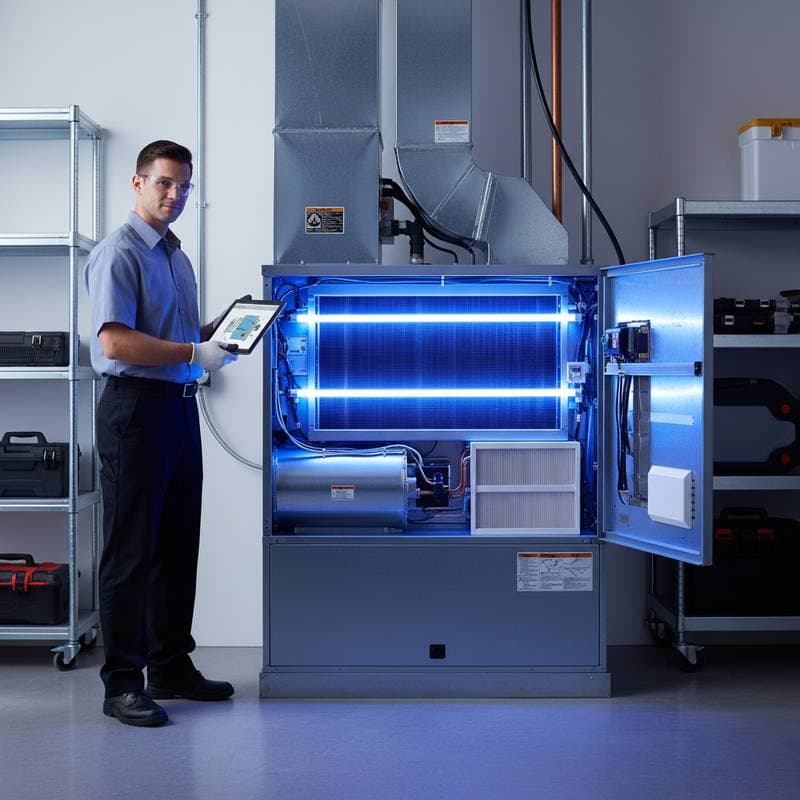The Hidden Costs of Skipping Spring AC Coil Cleaning
Neglecting spring maintenance for your AC coils can lead to expenses exceeding $800 in repairs, increased energy consumption, and a shortened system lifespan. Accumulated dirt forces the air conditioner to operate under strain, which elevates utility bills and accelerates wear on essential parts. A targeted cleaning investment safeguards efficiency and ensures reliable performance during peak summer demand. This article details the financial implications of oversight, influencing variables, and strategies for effective upkeep.
| Issue from Dirty Coils | Estimated Cost |
|---|---|
| Elevated Energy Bills | $100 - $300 per season |
| Compressor or Fan Motor Breakdown | $500 - $1,200 |
| Coil Replacement | $600 - $2,000 |
| Professional Coil Cleaning | $100 - $250 |
Understanding the Average Expenses from Dirty AC Coils
Dust, pollen, and debris on coils diminish system efficiency and cooling capacity. Such accumulation can increase energy demands by as much as 30 percent, potentially adding $200 or more to yearly electricity expenses. Overheating or excessive strain on the compressor may result in repair costs ranging from $500 to $1,200.
Coil replacement for severe damage often surpasses $800, with totals climbing into thousands based on system specifications. Professional cleaning, however, remains economical at $100 to $250, positioning it as a prudent annual measure.
Factors Influencing AC Coil Cleaning and Repair Expenses
Multiple elements determine the price of coil maintenance or subsequent fixes. Awareness of these aspects enables proactive choices to curb escalating issues.
Accessibility of the Coils
Coils positioned for straightforward external access allow for swift, low-cost servicing. Units with coils in attics, crawl spaces, or enclosed handlers demand extended labor, thereby raising fees.
Condition of the Coils
Light layers of dust or pollen yield to basic rinsing, but entrenched grime or mold necessitates specialized chemicals and thorough procedures. Advanced corrosion or deformed fins might require component swaps, inflating the overall charge.
Age and Efficiency Rating of the System
Aging units typically demand intensified care due to inherent vulnerabilities and reduced performance. Advanced models featuring slim fins or protective finishes call for delicate techniques, extending service duration.
Regional Labor Rates and Service Bundles
Technicians apply varying hourly fees influenced by location and task complexity. Opting for a comprehensive spring tune-up, which incorporates filter changes, refrigerant evaluations, and performance assessments, often yields savings on coil cleaning.
Essential AC Coil Types Requiring Maintenance
Air conditioning systems rely on two primary coil varieties, each demanding periodic attention to sustain operation.
Evaporator Coil (Indoor Unit)
Located within the air handler, the evaporator coil draws heat from interior spaces.
Benefits of Regular Cleaning:
- Enhances cooling output
- Controls indoor humidity
- Averts freezing within the system
Drawbacks of Neglect:
- Promotes ice formation and restricted airflow
- Fosters mold and unpleasant odors
- Risks compressor integrity
Condenser Coil (Outdoor Unit)
The condenser coil expels heat to the exterior environment.
Benefits of Regular Cleaning:
- Eases compressor operation
- Prolongs overall equipment durability
- Ensures steady temperature regulation
Drawbacks of Neglect:
- Amplifies power consumption
- Triggers thermal overload
- Impairs refrigerant circulation
Indicators That AC Coils Require Immediate Cleaning
Observe these warning signs to detect coil contamination early:
- Inconsistent or inadequate cooling across rooms
- Extended runtime or nonstop operation
- Visible ice on evaporator surfaces or lines
- Unexplained spikes in energy statements
- Unusual scents emanating from air outlets
- Recurrent circuit interruptions or abrupt shutdowns
Prompt intervention halts progression to major faults and reinstates optimal function.
Step-by-Step Professional Coil Cleaning Procedure
Technicians follow a systematic approach to coil restoration, delivering noticeable enhancements in system performance.
- Initial Assessment and Power Isolation
Power sources disconnect while coils undergo evaluation for contaminants and deterioration. - Panel Disassembly
Access covers remove to expose both indoor and outdoor components. - Initial Debris Removal
Brushes and vacuums eliminate loose particles, foliage, and surface accumulations. - Application of Cleaning Agents
Foams or solutions target embedded residues for dissolution. - Thorough Rinsing and Drying
Gentle water flushes clear residues, followed by air drying to inhibit corrosion. - Performance Verification
Upon reassembly, the system activates for checks on airflow, refrigerant charge, and cooling metrics.
Completion typically spans one to two hours, yielding instant efficiency gains.
Breakdown of Labor Expenses for Cleaning and Repairs
Hourly rates for coil servicing range from $75 to $125, varying by locale and unit intricacy. A routine visit totals $100 to $250 for most residential setups.
Component failures stemming from unclean coils, such as compressors or fans, escalate labor beyond $500 owing to specialized expertise. Proactive scheduling in spring outperforms emergency responses in cost control.
Common Questions on AC Coil Maintenance
How Frequently Do AC Coils Need Cleaning?
Annual cleaning suffices for most systems, with spring timing ideal prior to intense usage. Environments with heavy dust or allergens may warrant additional sessions.
Is DIY Cleaning of AC Coils Feasible?
Outdoor coils tolerate gentle hosing and brushing for superficial dirt, yet professionals handle intricate internal cleaning to preserve fin integrity and avoid harm.
What Are the Long-Term Effects of Ignoring Coil Cleaning?
Persistent dirt compels excessive effort from the unit, inflating bills, compromising cooling, and inviting compressor issues. Cumulative outlays may exceed $800 in avoidable expenditures.
Does Cleaning Coils Enhance Indoor Air Quality?
Affirmative; it minimizes dust, fungal elements, and dampness that infiltrate airways, thereby curbing irritants and allergens.
Are Cleaning Agents for Coils Environmentally Safe?
Certified solutions employed by experts prove non-abrasive and suitable for residential HVAC and surroundings. Steer clear of domestic abrasives that erode surfaces.
Does a Standard Tune-Up Encompass Coil Cleaning?
Numerous plans integrate this service; verify inclusions with providers to prevent redundant billing.
Steps to Safeguard Efficiency and Savings
Integrate spring coil cleaning into your routine to avert disruptions and optimize returns on your HVAC setup. Select certified technicians for precise execution, and monitor system cues year-round. This approach not only trims immediate costs but also bolsters long-term reliability and comfort.





